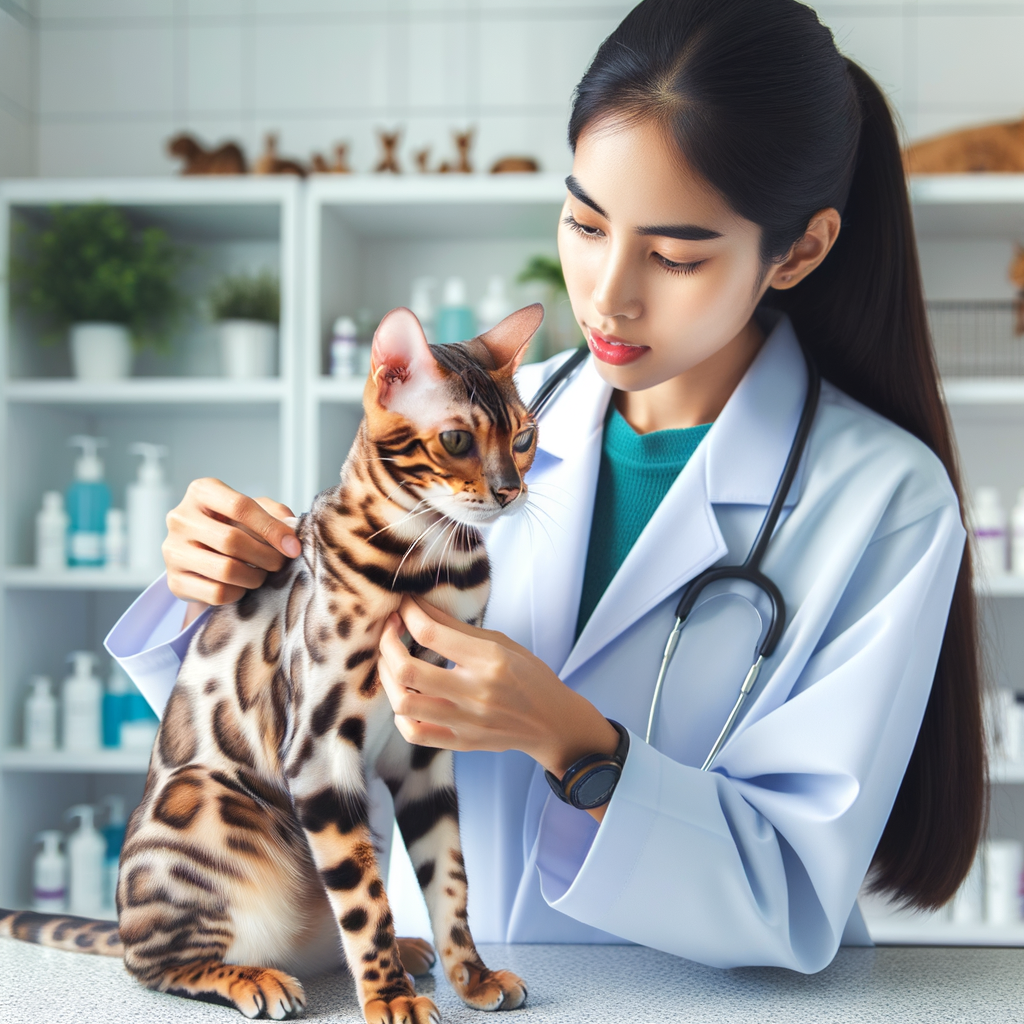
Introduction to Bengal Cat Skin Problems
- Overview of common Bengal cat skin conditions: Bengal cats, known for their beautiful coats, can suffer from various skin issues. These may include dermatitis, allergies, and infections.
- Bengal cat skin problems: Recognizing skin problems early can prevent them from getting worse. Proper knowledge ensures your Bengal cat stays healthy and comfortable. Early detection and treatment are key to maintaining their well-being.
Recognizing Bengal Cat Dermatitis
-
Signs and symptoms of Bengal cat dermatitis
- Red, inflamed skin: Your cat’s skin may look red and feel warm.
- Itching and scratching: Your Bengal might scratch a lot or bite its skin.
- Hair loss: You may notice bald spots where your cat has been scratching.
- Scabs and sores: Open wounds or scabs can form from constant scratching.
-
Causes of Bengal cat dermatitis
- Allergies: Cats can be allergic to food, pollen, or even dust. Allergies are a common cause of dermatitis.
- Parasites: Fleas, mites, and ticks can irritate your cat’s skin.
- Infections: Bacterial or fungal infections can lead to skin problems.
- Environmental factors: Dry air or harsh chemicals can cause skin irritation.
Bengal Cat Allergies
Common Allergens in Bengal Cats
Just like humans, Bengal cats can suffer from allergies. These allergies can cause discomfort and health problems.
- Food allergies: Some Bengal cats may be allergic to certain ingredients in their food. Common culprits include chicken, beef, dairy, and grains. Symptoms of food allergies can include vomiting, diarrhea, and itchy skin.
- Environmental allergies: Bengal cats can also be allergic to things in their environment. This can include pollen, dust mites, mold, and even certain cleaning products. Symptoms of environmental allergies often include sneezing, coughing, and skin irritation.
| Allergen Type | Common Sources | Symptoms |
|---|---|---|
| Food Allergies | Chicken, Beef, Dairy, Grains | Vomiting, Diarrhea, Itchy Skin |
| Environmental Allergies | Pollen, Dust Mites, Mold, Cleaning Products | Sneezing, Coughing, Skin Irritation |
Identifying Allergy Symptoms in Bengal Cats
- Excessive scratching and Bengal cat itchy skin: One of the most common signs of allergies in Bengal cats is excessive scratching. If your Bengal cat is constantly scratching, it may be due to itchy skin caused by an allergic reaction. This can lead to red, inflamed areas on their skin. According to a study, about 10% of cats suffer from some form of skin allergy.
- Bengal cat fur loss: Another symptom to watch for is fur loss. Allergies can cause your Bengal cat to lose patches of fur, especially around the neck, back, and tail. This can be distressing for both the cat and the owner. Regular grooming and checking for bald spots can help in early detection.
- Other physical symptoms: Besides scratching and fur loss, Bengal cats may show other physical symptoms of allergies. These can include watery eyes, sneezing, and even digestive issues like vomiting or diarrhea. If you notice any of these signs, consult your vet for proper diagnosis and treatment.
Bengal Cat Skin Treatment Options
Treating Bengal Cat Dermatitis
- Topical treatments: These are creams or ointments applied directly to the skin. They can help reduce inflammation and itching. Common topical treatments include hydrocortisone cream and antifungal ointments. Always consult your vet before using any topical treatments.
- Oral medications: These are pills or liquids given by mouth. They can help control more severe cases of dermatitis. Oral medications might include antihistamines, antibiotics, or steroids. Your vet will prescribe the right medication based on your cat’s specific needs.
Addressing Bengal Cat Allergies
-
Identifying and eliminating allergens
- Observe your cat’s behavior and symptoms.
- Consult with a veterinarian for allergy testing.
- Keep a diary of your cat’s reactions to different environments and foods.
-
Medication options for Bengal cat allergies
- Antihistamines: These can help reduce itching and swelling.
- Corticosteroids: These are stronger medications that reduce inflammation.
- Immunotherapy: This involves giving your cat small doses of the allergen to build up tolerance.
Dealing with Bengal Cat Skin Infections
-
Recognizing signs of a skin infection
- Redness: Look for red or inflamed areas on your cat’s skin.
- Itching: If your cat is scratching more than usual, it could be a sign of infection.
- Hair Loss: Patches of missing fur can indicate a problem.
- Sores or Scabs: Open wounds or scabs are clear signs of infection.
- Odor: A bad smell from the skin can be a sign of bacterial infection.
-
Effective treatments for Bengal cat skin infection
- Visit the Vet: Always start with a visit to the veterinarian. They can diagnose the infection and recommend the best treatment.
- Medications: Your vet may prescribe antibiotics or antifungal medications to treat the infection.
- Topical Treatments: Creams or ointments can help soothe the skin and fight infection.
- Bathing: Special medicated shampoos can help clean the skin and reduce infection.
- Diet: Sometimes, a change in diet can help improve your cat’s skin health. Your vet can recommend the best food for your cat.
| Sign of Infection | Action to Take |
|---|---|
| Redness | Visit the vet |
| Itching | Use prescribed medications |
| Hair Loss | Apply topical treatments |
| Sores or Scabs | Use medicated shampoos |
| Odor | Consider diet changes |
Bengal Cat Grooming Tips for Healthy Skin
- Regular brushing: Brushing your Bengal cat’s fur helps remove loose hair and dirt. It also spreads natural oils, keeping their coat shiny and healthy. Aim to brush your cat at least once a week. This can prevent matting and reduce shedding.
- Appropriate bathing techniques: Bengal cats generally do not need frequent baths. However, when you do bathe them, use a cat-specific shampoo. Avoid getting water in their ears and eyes. Make sure to rinse thoroughly to remove all soap residue. Bathing too often can strip their skin of natural oils, so limit baths to once every few months unless necessary.
- Importance of regular vet check-ups: Vets can spot early signs of skin problems and provide treatments. They can also recommend the best grooming products for your cat. Schedule check-ups at least once a year, or more often if your cat has ongoing skin issues.
Bengal Cat Skin Care: Preventive Measures
- Importance of a balanced diet: Make sure to feed them high-quality cat food that contains all the necessary nutrients. Omega-3 and Omega-6 fatty acids are particularly for maintaining healthy skin and a shiny coat. According to Wikipedia, these nutrients can help reduce inflammation and keep the skin supple.
- Benefits of regular exercise: Regular exercise is not only good for your cat’s overall health but also for their skin. Exercise helps improve blood circulation, which in turn nourishes the skin. Playing with your Bengal cat daily can keep them active and engaged, reducing the risk of skin issues.
- Keeping the living environment clean: A clean living environment is essential for preventing skin problems. Make sure to regularly clean your cat’s bedding, litter box, and play areas. Dust and allergens can cause skin irritations, so keeping the environment clean can help minimize these risks.
| Preventive Measure | Benefit |
|---|---|
| Balanced Diet | Provides essential nutrients for healthy skin |
| Regular Exercise | Improves blood circulation to nourish the skin |
| Clean Environment | Reduces exposure to dust and allergens |
Ensuring Your Bengal Cat’s Skin Health
-
Recap of Bengal cat skin problems and solutions:
- Bengal cats can suffer from various skin problems like dermatitis, allergies, and infections.
- Recognizing symptoms early, such as itching, redness, or hair loss, is essential.
- Treatment options include medicated shampoos, topical treatments, and dietary changes.
- Preventive measures like regular grooming and a balanced diet can help maintain healthy skin.
-
Importance of regular vet visits and early detection:
- Regular vet check-ups can catch skin issues early before they become severe.
- Early detection and treatment can prevent discomfort and more serious health problems.
- Vets can provide professional advice tailored to your Bengal cat’s specific needs.
| Key Point | Details |
|---|---|
| Common Skin Problems | Dermatitis, allergies, infections |
| Symptoms to Watch For | Itching, redness, hair loss |
| Treatment Options | Medicated shampoos, topical treatments, dietary changes |
| Preventive Measures | Regular grooming, balanced diet |
| Importance of Vet Visits | Early detection, professional advice |






